
Wetenschap
Waar het begint:jonge hongerige sprinkhanen stapelen zich op in Somalië
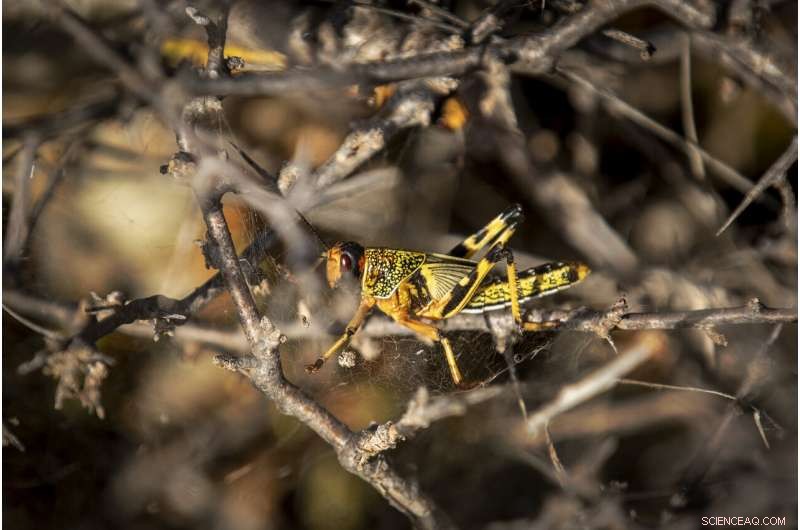
Op deze foto, dinsdag genomen, 4 februari 2020, een jonge woestijnsprinkhaan die nog geen vleugels heeft gekregen, zit vast in een spinnenweb op een doornstruik in de woestijn bij Garowe, in de semi-autonome regio Puntland in Somalië. De woestijnsprinkhanen in dit dorre deel van Noord-Somalië zien er minder onheilspellend uit dan de zwermen met miljarden leden die Oost-Afrika teisteren, maar de springende jonge sprinkhanen zijn de volgende golf in de uitbraak die meer dan 10 miljoen mensen in de hele regio bedreigt met een ernstige hongercrisis. (AP Foto/Ben Curtis)
In een oogopslag, de woestijnsprinkhanen in dit dorre deel van Noord-Somalië zien er minder onheilspellend uit dan de zwermen met miljarden leden die Oost-Afrika teisteren tijdens de ergste uitbraak die sommige plaatsen in 70 jaar hebben gezien.
Maar hun tijd zal komen.
Klein en vleugelloos, de springende jonge sprinkhanen zijn de volgende golf in de uitbraak die meer dan 10 miljoen mensen in de regio bedreigt met een ernstige hongercrisis.
En ze groeien op op een van de meest ontoegankelijke plekken op aarde. Grote delen van Somalië ten zuiden van deze semi-autonome regio Puntland worden bedreigd, of vastgehouden door, de aan al-Qaida gelieerde extremistische groepering al-Shabab. Dat maakt het moeilijk of onmogelijk om de sprinkhanen vanuit de lucht te besproeien, wat volgens experts de enige effectieve bestrijding is.
Somalië heeft de uitbraak uitgeroepen tot nationale noodsituatie. Door de hele regio, het heeft het potentieel om "de meest verwoestende sprinkhanenplaag in al onze levende herinneringen te zijn als we het probleem niet sneller verminderen dan we op dit moment doen, "VN-chef voor humanitaire hulp Mark Lowcock zei.
Terwijl een gewapende Somalische politieman erbij stond, experts liepen donderdag over het droge land krioelden van de jonge sprinkhanen en legden de dreiging uit die zou komen als de wereld nu niet handelt.
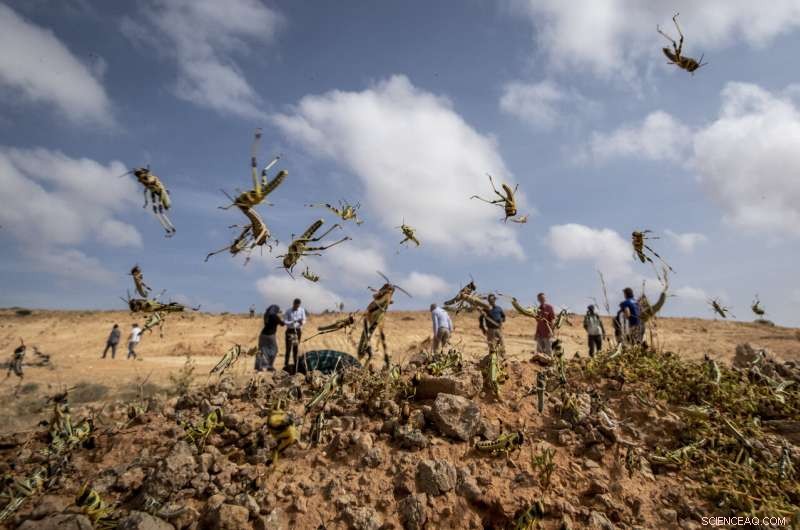
Op deze foto, woensdag genomen, 5 februari 2020, jonge woestijnsprinkhanen die nog geen vleugels hebben, springen in de lucht als ze worden benaderd, terwijl een bezoekende delegatie van de Voedsel- en Landbouworganisatie (FAO) hen observeert, in de woestijn bij Garowe, in de semi-autonome regio Puntland in Somalië. De woestijnsprinkhanen in dit dorre deel van Noord-Somalië zien er minder onheilspellend uit dan de zwermen met miljarden leden die Oost-Afrika teisteren, maar de springende jonge sprinkhanen zijn de volgende golf in de uitbraak die meer dan 10 miljoen mensen in de hele regio bedreigt met een ernstige hongercrisis. (AP Foto/Ben Curtis)
"De wereld moet weten dat dit is waar het allemaal begint, " zei Alberto Trillo Barça, een woordvoerder van de Voedsel- en Landbouworganisatie van de Verenigde Naties. "In de komende drie of vier weken, deze nimfen, zoals we ze noemen, vleugels zullen ontwikkelen."
Daarna vertrekken ze naar de buurlanden Kenia en Ethiopië, waar een handvol vliegtuigen die pesticiden sproeien alleen zoveel kan doen als zulke zwermen blijven aankomen.
Klimaatexperts hebben gewezen op ongewoon zware regenval, geholpen door een krachtige cycloon voor de kust van Somalië in december, als een belangrijke factor in de uitbraak. De sprinkhanen werden meegevoerd door de stormwinden van het Arabisch Schiereiland en delen daarbuiten, en nu voeden ze zich met de verse vegetatie van Somalië.
Aangezien er de komende weken meer regen in de regio wordt verwacht, het aantal sprinkhanen zou, indien niet aangevinkt, in juni tot 500 keer kunnen groeien, wanneer droger weer wordt verwacht.
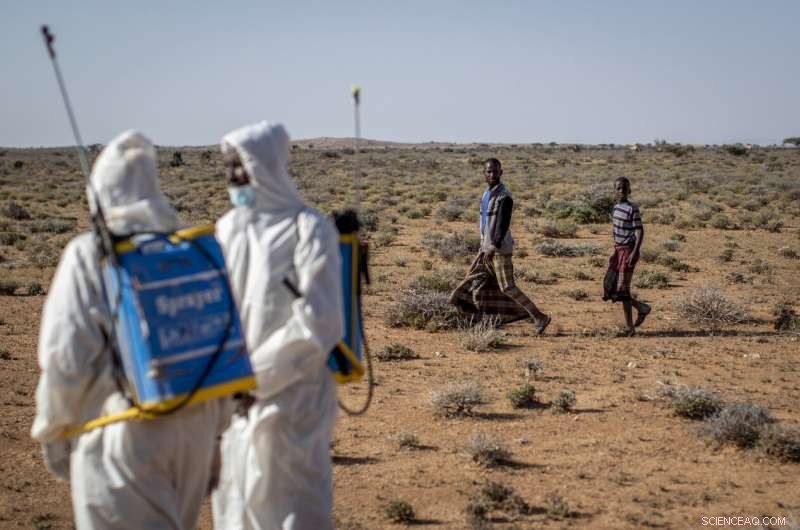
Op deze foto, dinsdag genomen, 4 februari 2020, Somalische sproeiers voor ongediertebestrijding demonstreren hun werk op de doornstruiken in de woestijn die de broedplaats is van woestijnsprinkhanen voor een bezoekende delegatie van Somalische ministeries en experts van de Voedsel- en Landbouworganisatie (FAO), in de woestijn bij Garowe, in de semi-autonome regio Puntland in Somalië. De woestijnsprinkhanen in dit dorre deel van Noord-Somalië zien er minder onheilspellend uit dan de zwermen met miljarden leden die Oost-Afrika teisteren, maar de springende jonge sprinkhanen zijn de volgende golf in de uitbraak die meer dan 10 miljoen mensen in de hele regio bedreigt met een ernstige hongercrisis. (AP Foto/Ben Curtis)
Maar dat drogere weer is niet per se de oplossing, zei Dominique Burgeon, directeur noodhulp en veerkracht van de FAO.
De dichtheid van de sprinkhanen is nu zo hoog dat zelfs normaal vocht kan leiden tot een nieuwe generatie, hij zei.
"We kunnen niet geloven in Moeder Natuur om het op te lossen, " hij legde uit.
Zonder voldoende sproeien om de zwermen te stoppen, de toch al zorgwekkende uitbraak kan uitmonden in een plaag, "en als je een plaag hebt, het duurt jaren om te controleren, " hij zei.
Tegen die ingrijpende vooruitzichten, een paar gemaskerde arbeiders met witte beschermende pakken en containers met pesticiden op hun rug stonden in de door kamelen doorkruiste Somalische woestijn, het spuwen van de duizenden sprinkhanen die zich aan doornstruiken vastklampen.
Het veranderende klimaat in de wereld brengt het risico met zich mee dat er meer cyclonen komen uit de opwarmende Indische Oceaan voor Oost-Afrika, zeggen klimaatexperts. Met dat, de kans op verdere sprinkhanenuitbraken groeit.
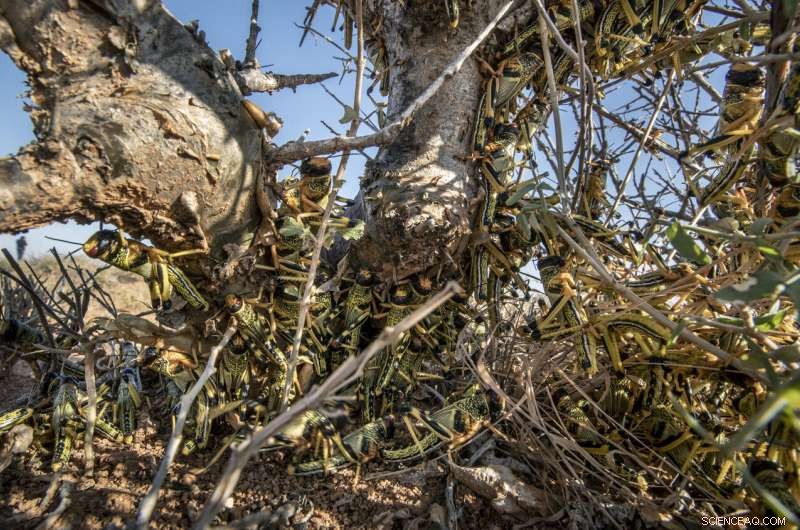
Op deze foto, dinsdag genomen, 4 februari 2020, jonge woestijnsprinkhanen die nog geen vleugels hebben, verdringen zich op een doornstruik in de woestijn bij Garowe, in de semi-autonome regio Puntland in Somalië. De woestijnsprinkhanen in dit dorre deel van Noord-Somalië zien er minder onheilspellend uit dan de zwermen met miljarden leden die Oost-Afrika teisteren, maar de springende jonge sprinkhanen zijn de volgende golf in de uitbraak die meer dan 10 miljoen mensen in de hele regio bedreigt met een ernstige hongercrisis. (AP Foto/Ben Curtis)
The "sort of new normal, " Burgeon said.
And that means Kenya, Ethiopia and other East African countries that rarely see such outbreaks and found themselves largely unprepared for this one could join "frontline countries" in parts of West Africa and the Middle East, deskundigen zeggen. Those countries have well-trained monitoring and prevention systems in place for more frequent locust outbreaks.
The FAO has asked international donors to give $76 million immediately to help control this outbreak. So far $19 million is in hand, Burgeon said.
"The biggest challenge is the scale of the breeding, as you can see all around us, " Barca said. These locusts, hij zei, will be migrating to southern Somalia and parts of Kenya and Ethiopia just as crops are germinating there.
"If at that time there are huge quantities of locusts around, it will have a devastating impact on the crops, " Burgeon said.
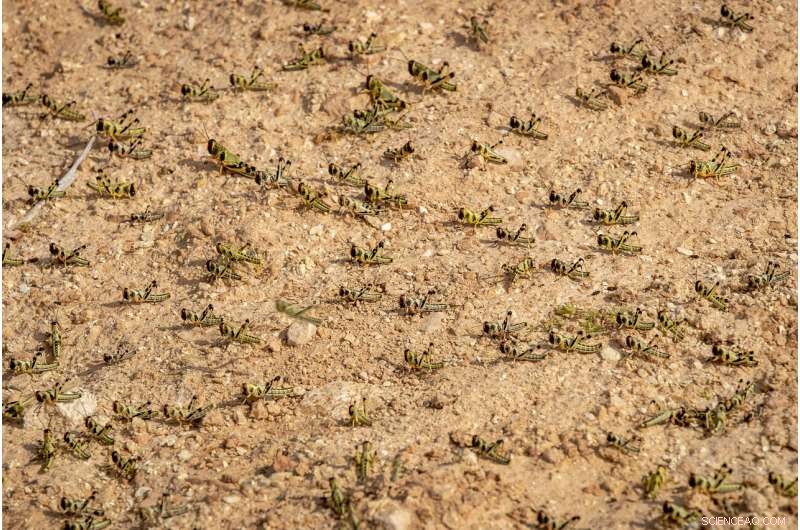
In this photo taken Wednesday, Feb. 5, 2020, young desert locusts that have not yet grown wings cover the ground in the desert near Garowe, in the semi-autonomous Puntland region of Somalia. The desert locusts in this arid patch of northern Somalia look less ominous than the billion-member swarms infesting East Africa, but the hopping young locusts are the next wave in the outbreak that threatens more than 10 million people across the region with a severe hunger crisis. (AP Photo/Ben Curtis)
Other East African countries including Uganda, Zuid Soedan, Eritrea and Djibouti are also at risk, Burgeon said. Millions of people in some of these places are already facing hunger in the wake of civil war or more common challenges such as poverty.
Here in rural Somalia, where about 50% of the people depend on animals for their livelihoods, the locusts are eating the pasturage. The animals weaken, their milk decreases and small children, who depend on the milk to survive, suffer skyrocketing malnutrition, the experts said.
Those fighting the locust outbreak may try to negotiate with Somalia's extremist fighters to allow spraying in rural areas where they are active, Burgeon said. Already emergency workers are going in where they can.
In a few weeks the young locusts will shed their skin, said Keith Cressman, a senior locust forecasting officer with the FAO.
-
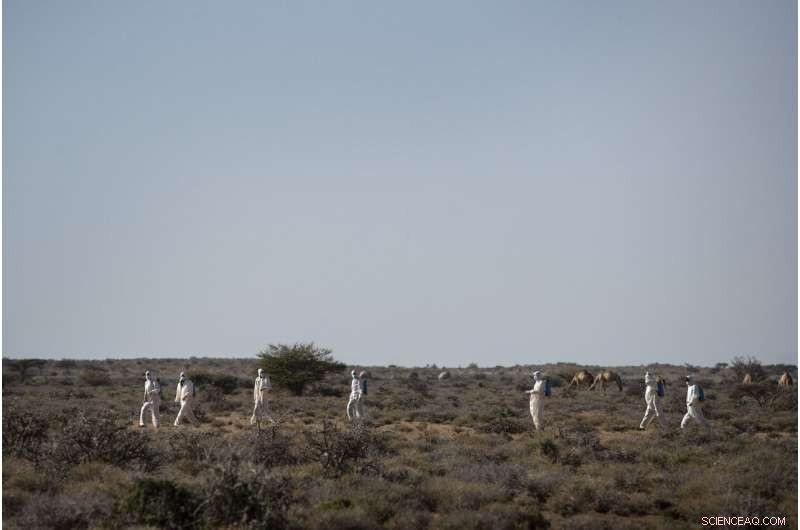
In this photo taken Tuesday, Feb. 4, 2020, Somali pest-control sprayers demonstrate their work on the thorny bushes in the desert that is the breeding ground of desert locusts for a visiting delegation of Somali ministry officials and experts from the Food and Agriculture Organization (FAO), in the desert near Garowe, in the semi-autonomous Puntland region of Somalia. The desert locusts in this arid patch of northern Somalia look less ominous than the billion-member swarms infesting East Africa, but the hopping young locusts are the next wave in the outbreak that threatens more than 10 million people across the region with a severe hunger crisis. (AP Photo/Ben Curtis)
-
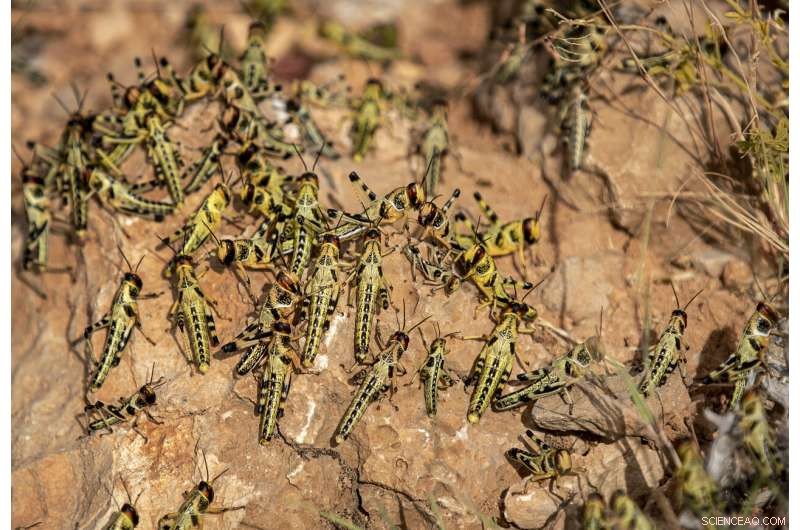
In this photo taken Wednesday, Feb. 5, 2020, young desert locusts that have not yet grown wings crowd together on a rock in the desert near Garowe, in the semi-autonomous Puntland region of Somalia. The desert locusts in this arid patch of northern Somalia look less ominous than the billion-member swarms infesting East Africa, but the hopping young locusts are the next wave in the outbreak that threatens more than 10 million people across the region with a severe hunger crisis. (AP Photo/Ben Curtis)
-
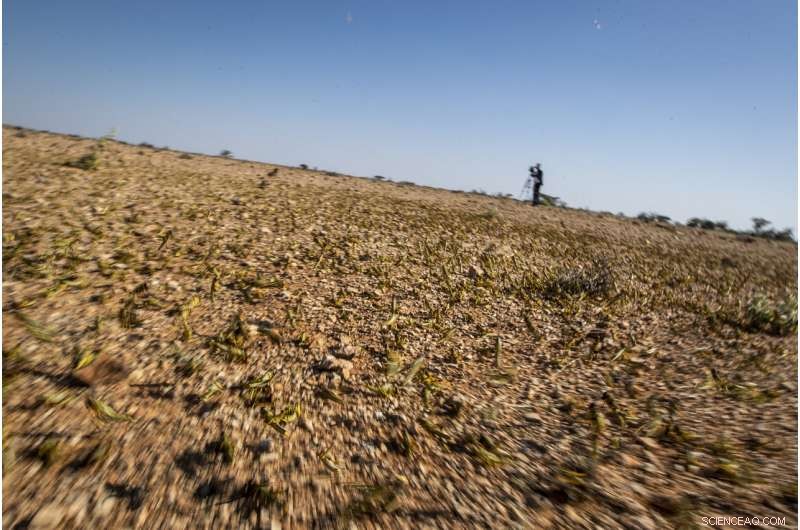
In this photo taken Tuesday, Feb. 4, 2020, young desert locusts that have not yet grown wings jump in the air as they are approached in the desert near Garowe, in the semi-autonomous Puntland region of Somalia. The desert locusts in this arid patch of northern Somalia look less ominous than the billion-member swarms infesting East Africa, but the hopping young locusts are the next wave in the outbreak that threatens more than 10 million people across the region with a severe hunger crisis. (AP Photo/Ben Curtis)
-
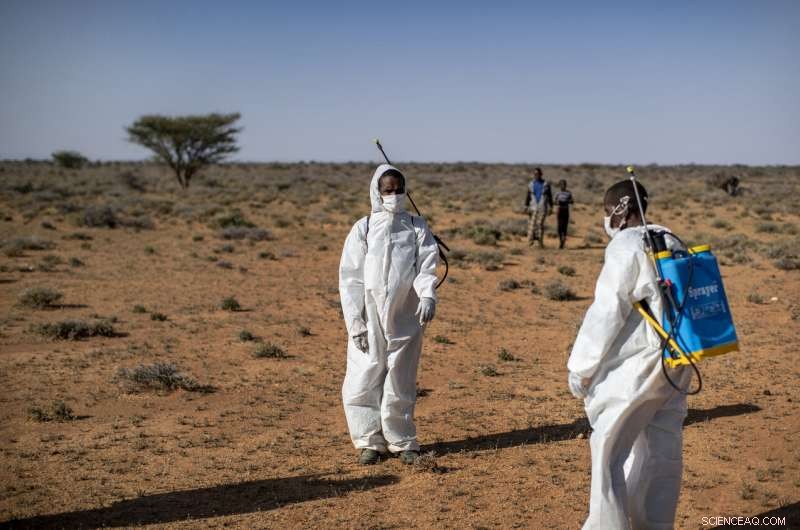
In this photo taken Tuesday, Feb. 4, 2020, Somali pest-control sprayers demonstrate their work on the thorny bushes in the desert that is the breeding ground of desert locusts for a visiting delegation of Somali ministry officials and experts from the Food and Agriculture Organization (FAO), in the desert near Garowe, in the semi-autonomous Puntland region of Somalia. The desert locusts in this arid patch of northern Somalia look less ominous than the billion-member swarms infesting East Africa, but the hopping young locusts are the next wave in the outbreak that threatens more than 10 million people across the region with a severe hunger crisis. (AP Photo/Ben Curtis)
-
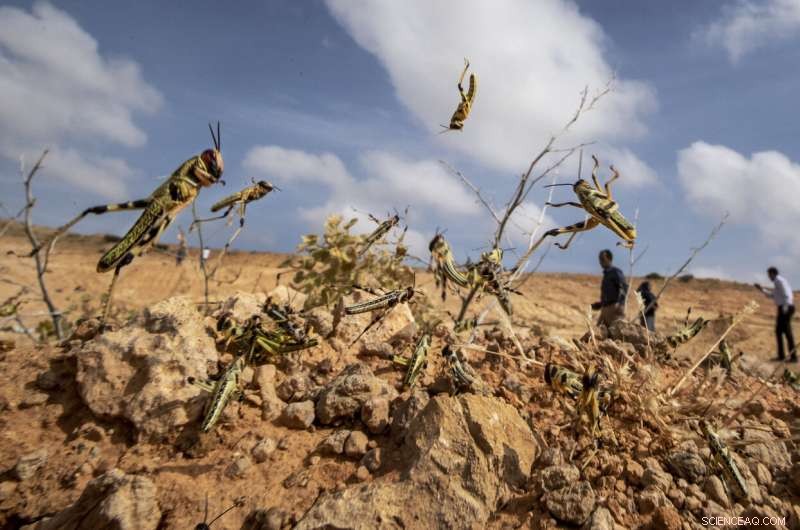
In this photo taken Wednesday, Feb. 5, 2020, young desert locusts that have not yet grown wings jump in the air as they are approached, as a visiting delegation from the Food and Agriculture Organization (FAO) observes them, in the desert near Garowe, in the semi-autonomous Puntland region of Somalia. The desert locusts in this arid patch of northern Somalia look less ominous than the billion-member swarms infesting East Africa, but the hopping young locusts are the next wave in the outbreak that threatens more than 10 million people across the region with a severe hunger crisis. (AP Photo/Ben Curtis)
-
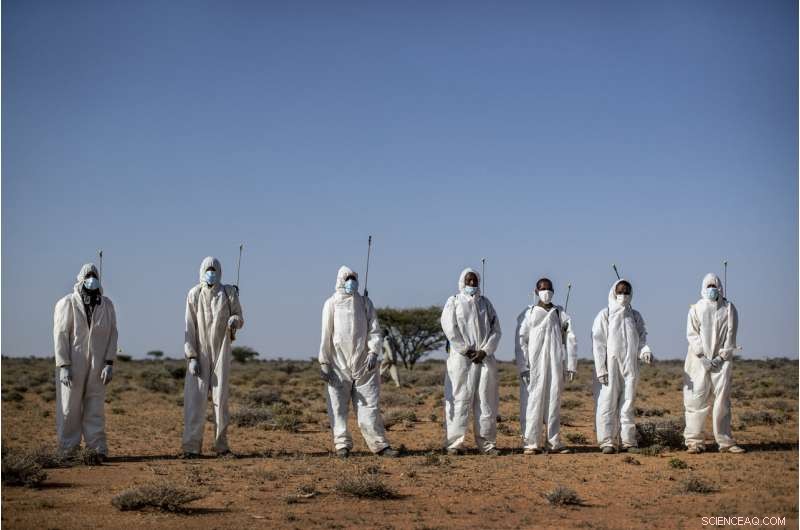
In this photo taken Tuesday, Feb. 4, 2020, pest-control sprayers demonstrate their work on the thorny bushes in the desert that is the breeding ground of desert locusts for a visiting delegation of Somali ministry officials and experts from the Food and Agriculture Organization (FAO), in the desert near Garowe, in the semi-autonomous Puntland region of Somalia. The desert locusts in this arid patch of northern Somalia look less ominous than the billion-member swarms infesting East Africa, but the hopping young locusts are the next wave in the outbreak that threatens more than 10 million people across the region with a severe hunger crisis. (AP Photo/Ben Curtis)
-
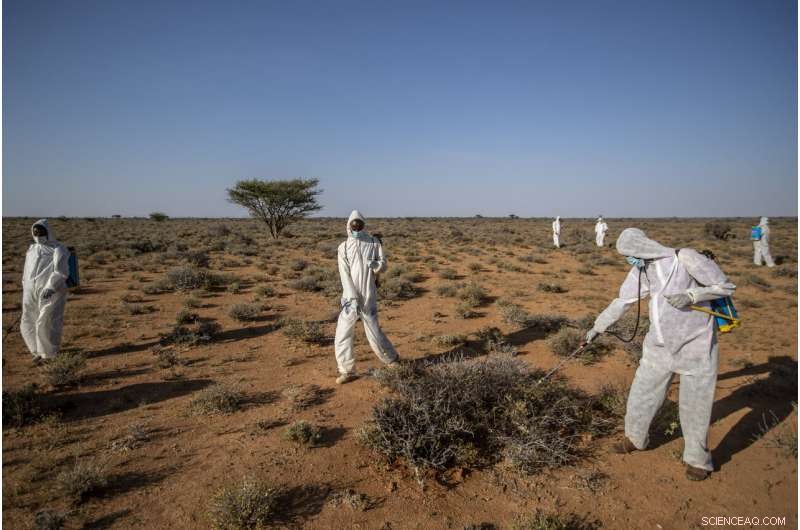
In this photo taken Tuesday, Feb. 4, 2020, pest-control sprayers demonstrate their work on the thorny bushes in the desert that is the breeding ground of desert locusts for a visiting delegation of Somali ministry officials and experts from the Food and Agriculture Organization (FAO), in the desert near Garowe, in the semi-autonomous Puntland region of Somalia. The desert locusts in this arid patch of northern Somalia look less ominous than the billion-member swarms infesting East Africa, but the hopping young locusts are the next wave in the outbreak that threatens more than 10 million people across the region with a severe hunger crisis. (AP Photo/Ben Curtis)
-
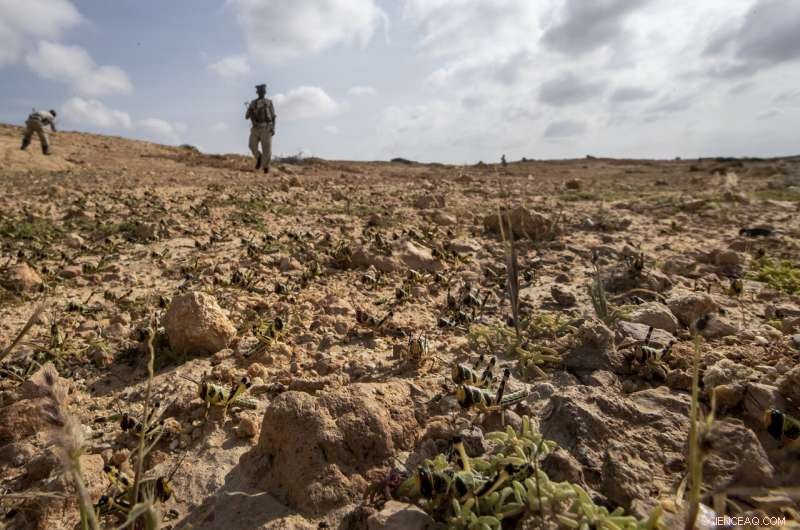
In this photo taken Wednesday, Feb. 5, 2020, a policeman looks at young desert locusts that have not yet grown wings covering the ground in the desert near Garowe, in the semi-autonomous Puntland region of Somalia. The desert locusts in this arid patch of northern Somalia look less ominous than the billion-member swarms infesting East Africa, but the hopping young locusts are the next wave in the outbreak that threatens more than 10 million people across the region with a severe hunger crisis. (AP Photo/Ben Curtis)
-
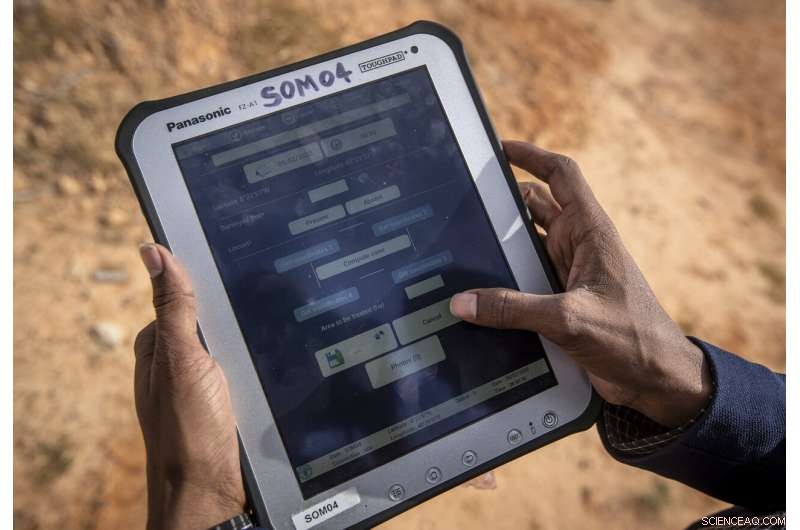
In this photo taken Wednesday, Feb. 5, 2020, an official from the Food and Agriculture Organization (FAO) demonstrates the "eLocust3" software used to record and track the location and movements of locusts using GPS and transmit the data via satellite, in the desert near Garowe, in the semi-autonomous Puntland region of Somalia. The desert locusts in this arid patch of northern Somalia look less ominous than the billion-member swarms infesting East Africa, but the hopping young locusts are the next wave in the outbreak that threatens more than 10 million people across the region with a severe hunger crisis. (AP Photo/Ben Curtis)
-

In this photo taken Wednesday, Feb. 5, 2020, Dominique Burgeon, centrum, Director of the Emergency and Resilience Division of the Food and Agriculture Organization (FAO) and Keith Cressman, Rechtsaf, Senior Locust Forecasting Officer for FAO, walk in the desert between Garowe and Qardho, in the semi-autonomous Puntland region of Somalia. The desert locusts in this arid patch of northern Somalia look less ominous than the billion-member swarms infesting East Africa, but the hopping young locusts are the next wave in the outbreak that threatens more than 10 million people across the region with a severe hunger crisis. (AP Photo/Ben Curtis)
"It takes a few days to warm up their wings, " he said. Some test flights follow and they're on the move.
The locusts at that stage are bright pink and in their most voracious state, like "very hungry teenagers, " Cressman said. By now, many people in Kenya and Ethiopia know them well.
After a month or so, the locusts will be mature adults, ready to reproduce.
Soon after copulating and laying eggs the locusts will die, "but their progeny will be hatching, " Cressman said. "And we have another generation of locusts to contend with, with about another 20-fold increase."
© 2020 The Associated Press. Alle rechten voorbehouden.
 Hoe een zuur neutraliseren
Hoe een zuur neutraliseren  Wat zijn drie verschillen tussen de boven- en ondermantel?
Wat zijn drie verschillen tussen de boven- en ondermantel?  Op cellulose-nanofibril gebaseerde inkapselingsstructuur om de afgifte van geneesmiddelen te regelen
Op cellulose-nanofibril gebaseerde inkapselingsstructuur om de afgifte van geneesmiddelen te regelen Polymeerfilm beschermt tegen elektromagnetische straling, signaal interferentie
Polymeerfilm beschermt tegen elektromagnetische straling, signaal interferentie Formaatdehydrogenase reduceert koolstofdioxide tot mierenzuur
Formaatdehydrogenase reduceert koolstofdioxide tot mierenzuur
 Een derde van ons afval is afkomstig van gebouwen. Deze zijn ontworpen voor hergebruik en verminderen de uitstoot met 88%
Een derde van ons afval is afkomstig van gebouwen. Deze zijn ontworpen voor hergebruik en verminderen de uitstoot met 88% Locals vluchten terwijl orkaanvaten worden versterkt richting het zuiden van de VS
Locals vluchten terwijl orkaanvaten worden versterkt richting het zuiden van de VS Wildvuur in West-Australië verbrandt meer huizen bij droge wind
Wildvuur in West-Australië verbrandt meer huizen bij droge wind Een kaart die een gat van 500 miljoen jaar in de geschiedenis van de aarde opvult
Een kaart die een gat van 500 miljoen jaar in de geschiedenis van de aarde opvult Ardern toert verwoestende overstromingen in Nieuw-Zeeland
Ardern toert verwoestende overstromingen in Nieuw-Zeeland
Hoofdlijnen
- De ontdekking van een mijlpaal verandert de evolutiemarathon in een sprint
- Oncogene: wat is het? & Hoe beïnvloedt het de celcyclus?
- Amylase Activity in the Stomach
- Nieuwe intermoleculaire oppervlaktekracht onthult actomyosine-aandrijfmechanisme
- Waarom lopen mensen meestal in dezelfde richting?
- Doen eukaryote cellen door binaire fissie?
- Hoeveel chromosomen zijn er in cellen van het menselijk lichaam?
- Wat is landbouwbiotechnologie?
- Hoe gigantische tropische fruitvleermuizen te redden:werk samen met lokale jagers die vleermuistanden als geld gebruiken
- Boeren die zich niet bewust zijn van hun activiteiten veroorzaken klimaatschokken
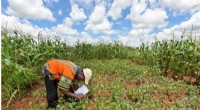
- Klimaatverandering, houtkap botst - en een bos krimpt

- Osmose-experimenten met Gummy Bears

- Wandelaars klauteren terwijl nieuwe spleet zich opent bij IJslandse vulkaan

- Gigantische massa warm water voor de kust van de Stille Oceaan kan wedijveren met de blob

 Een nieuwe soort zwarte keverlarven die plastic afbreken
Een nieuwe soort zwarte keverlarven die plastic afbreken COVID dwingt miljoenen meisjes om niet naar school te gaan in Zuidoost-Azië en de Stille Oceaan
COVID dwingt miljoenen meisjes om niet naar school te gaan in Zuidoost-Azië en de Stille Oceaan Feiten over neonlichten
Feiten over neonlichten  VS machtigt verschillende bedrijven om te verkopen aan Huawei te midden van sancties
VS machtigt verschillende bedrijven om te verkopen aan Huawei te midden van sancties Door phonon gemedieerde overdracht van kwantumtoestanden en qubit-verstrengeling op afstand
Door phonon gemedieerde overdracht van kwantumtoestanden en qubit-verstrengeling op afstand Math-problemen oplossen in een 3X3-raster
Math-problemen oplossen in een 3X3-raster  Onderzoeken hoe verhalende stijlfiguren samenkomen in populaire films
Onderzoeken hoe verhalende stijlfiguren samenkomen in populaire films Goedkoop, energiezuinige en schone reactie om chemische grondstof te maken
Goedkoop, energiezuinige en schone reactie om chemische grondstof te maken
- Elektronica
- Biologie
- Zonsverduistering
- Wiskunde
- French | Italian | Spanish | Portuguese | Swedish | German | Dutch | Danish | Norway |

-
Wetenschap © https://nl.scienceaq.com

